You’d think that a landscape designer who also does landscape maintenance would be dismissive of the whole low-maintenance gardening thing. After all, there’s a negative impression of low-maintenance gardens as being dull, static, lifeless places devoid of wildlife or any personal character.
But there is a balance in a well-designed garden between hardscape (the patios, walkways, raised beds, and other permanent structures), the shrubs and trees that require little care beyond formative pruning and appropriate watering, and the flowers, grasses, veggies and bulbs that invite your personality to shine yet do require more care to keep up.
Finding that perfect balance is what this book is all about, so when Timber Press sent me a copy to review, I was excited to dig in. This book is an inspiring manifesto that introduces you to gardeners who have found that balance between caring for their garden, and having time to just enjoy their garden.
It’s not about skipping out on maintenance altogether, because many of the gardens featured have flowering plants, veggies and container gardens that do require care.
It is about figuring out what really touches your soul in a garden, and thinking carefully about how to edit your “must-haves” down to a few key elements. The end result is a garden that feels lush and bold, yet requires less time to care for and focuses your attention only on the more enjoyable tasks in gardening.
Some of her advice for creating the new style of low-maintenance garden:
- Keep it small: a small garden requires less time and resources to care for.
- Most of the garden is not actually planted in the ground, to avoid weeding. Pavers, gravel laid over landscape fabric, or other usable entertaining areas take the place of lawn, and planting is done in raised beds, troughs or large containers to avoid weeding areas of ground that don’t need to be planted.
- Take good care of your soil and use ample amounts of mulch to help plants be less dependant on you.
- Use drip irrigation systems to free you from the endless chore of hand-watering.
- Use screening to create small, manageable spaces that you can design carefully and maintain with ease. In the screened-off areas of the garden you can place garden sheds, compost bins, and out-of-season planting containers or chairs.
- Use the screening you create as vertical gardening space to pack more plants and interest into a small area.
- Carefully edit your plant list to make sure every plant is attractive in multiple seasons and doesn’t need spraying or dividing. Rely heavily on plants that provide year-round foliage interest, and use flowers strategically in places where you’ll really notice them.
These are just a few of the basic concepts presented.
Easton then takes us on a garden tour, profiling a number of differently-styled gardens. She talks with the gardeners who created these personal, beautiful spaces to learn how they developed their garden plan, what was important to them in creating and changing their garden, and how they use the garden now.
Throughout each section, Easton gives tips on how to use groundcovers effectively, avoid invasive plants that can turn into a maintenance nightmare, or get rid of weeds organically. The tips are practical and focused, and if you’re anything like me, you’ll have a number of bookmarks through the book by the time you’re done reading.
One thing to note is that many of the gardens incorporate elements that are decidedly not low-maintenance, such as a large plantings of annual Impatiens, or annual vegetables that need refreshing throughout the year. But this is consistent with her philosophy that garden maintenance be about figuring out your priorities and editing down to just the most important elements.
It’s not about no-maintenance, it’s about choosing the type and amount of maintenance that works for you and gets you the results you most desire in your garden.
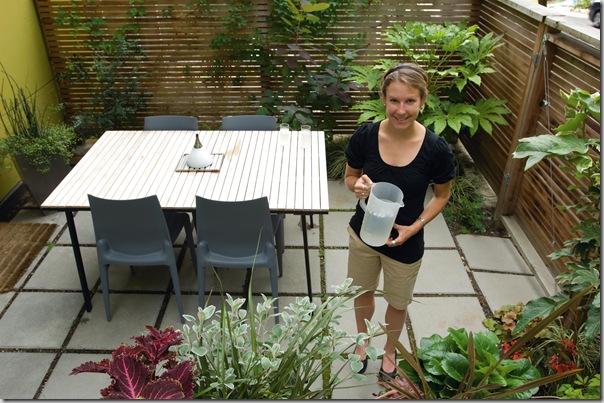 The author also discusses using container plants as a way of reducing maintenance. She points out that if you use drip irrigation and create permanent container plantings of shrubs and trees, container plantings can be a low-maintenance way of avoiding the bending and weeding of gardening in the ground. Container plants do need to be repotted periodically in order to thrive (which can be an intimidating task!), but I agree with her point that the bold look of containers can reduce the number of plantings needed to create a lush, green environment.
The author also discusses using container plants as a way of reducing maintenance. She points out that if you use drip irrigation and create permanent container plantings of shrubs and trees, container plantings can be a low-maintenance way of avoiding the bending and weeding of gardening in the ground. Container plants do need to be repotted periodically in order to thrive (which can be an intimidating task!), but I agree with her point that the bold look of containers can reduce the number of plantings needed to create a lush, green environment.
If I have one quibble with the book, it is that some of the photos of container plants she features have plantings that are gorgeous, but unrealistically crammed with plants that will outgrow their pots and overwhelm the things they are growing with. I worry that new gardeners won’t understand that this is inspirational eye candy and not the good long-term planting practice she advises in her text.
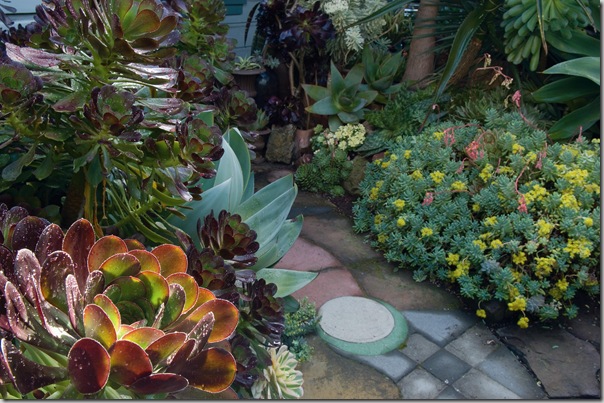 For me, the strength of this book was in the incredible variety of styles used and the people profiled. Seeing so many different kinds of garden allowed me to take some ideas or philosophies from each place, and get a better idea of what I might like in my own home garden. I’m also excited to be able to bring this book along when meeting clients, to show them some of the possibilities for a low-maintenance space.
For me, the strength of this book was in the incredible variety of styles used and the people profiled. Seeing so many different kinds of garden allowed me to take some ideas or philosophies from each place, and get a better idea of what I might like in my own home garden. I’m also excited to be able to bring this book along when meeting clients, to show them some of the possibilities for a low-maintenance space.
The photos by Jacqueline H. Koch were gorgeous – a perfect match with Easton’s writing. They helped me get a real vision and feeling for what this style of gardening might look like. It was great to be able to take direct inspiration from the plant and material combinations used in the book.
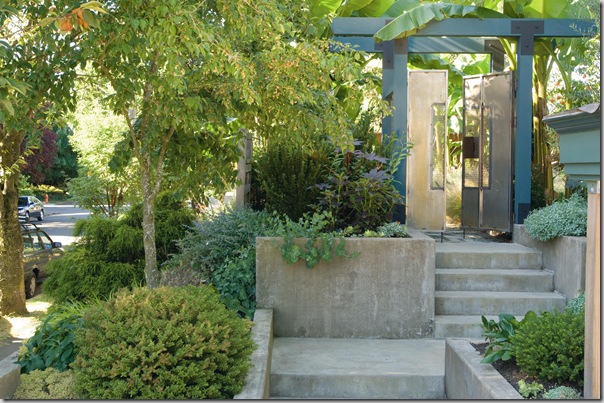
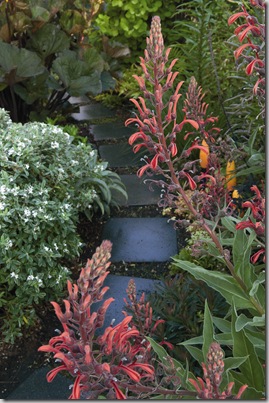 Overall, this book provides a whole new philosophy for gardening that will guide you in designing (or re-designing) your outdoor spaces. The photos are stunning and varied, and you are sure to find a number of ideas that inspire you and make you think of your own garden differently.
Overall, this book provides a whole new philosophy for gardening that will guide you in designing (or re-designing) your outdoor spaces. The photos are stunning and varied, and you are sure to find a number of ideas that inspire you and make you think of your own garden differently.
In addition, the tips are practical, environmentally friendly, and geared towards having a garden that enriches your life and gives you and your family a place to appreciate nature and each other. It’s gardening for today’s gardeners – busy people who want to balance gardening with the other aspects of their lives.
I’ll leave you with some words from the author about what The NEW Low-Maintenance Garden is really about:
“We’re gardening in the new millennium, though you’d never know it by looking at our gardens. We mostly garden as our grandparents did, albeit with a far greater palette of plants and maybe fewer straight rows.
…We need to face up to the realities of less time and more stress as well as volatile weather, less water, and higher prices for land, housing, and everything else… which brings us to the idea that truly modern gardens are about far more than design.
It’s the essence of a garden that defines its modernity, not its style, materials, or ornamentation. Naturalistic gardens uniquely born of their specific locations are modern, as are gardens rich in native plants that nurture and protect living creatures.
Organic, sustainable gardens are the new avant-garde. So is growing your own food, composting, water catchment and recycling. Not depleting our own or the earth’s energies as we garden is the most modern, and eminently reachable, of ideas.”
Resources:
Read more about the book at Timber Press or Amazon.com
Listen to the author discuss low-maintenance gardening on the Timber Press Podcast
Read the author’s blog, Plant Talk
Photo credits: Jacqueline H. Koch, used with permission of Timber Press
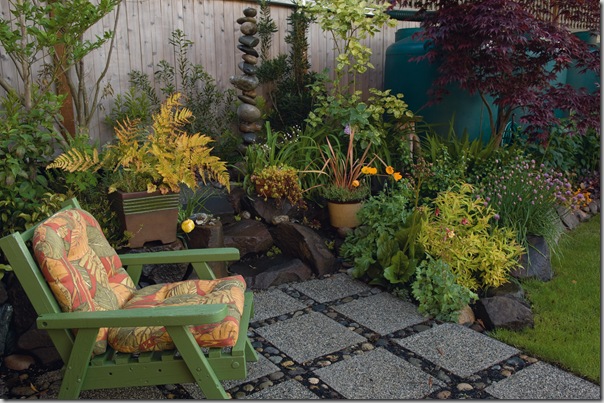
5 responses to “Book Review: The NEW Low-Maintenance Garden by Valerie Easton”
What a great review, Gen. I had the opportunity to hear Val speak at The Late Show Gardens, last year in Sonoma. She spoke to a packed house, and everyone really, really enjoyed her presentation. The line was so long afterwards that I didn’t have a chance to buy her book, but after your glowing review I’ll be sure to get one – I think the longer we garden, and the older we get, the more we appreciate beauty that isn’t quite as ‘fleeting’…and I’m ALL for having a low-maintenance, yet gorgeous garden!
Excellent book recommendation. I am checking it out. I love that A. attenuata nestle in that garden space. Need to get up to WA to see here talk. Matti
Thanks, Genevieve, for a lovely and thorough review. I appreciate it, and am honored to be reviewed on “North Coast Gardening”….
Val Easton
I *loved* this book. I read it cover-to-cover, and now I keep it in my bathroom and look at all the pictures when I take a bath. There are a couple of passages that are so well written that I even enjoy re-reading them just for the fun of it.
[…] of interviews with Timber Press’ authors, who are universally awesome. They’ve interviewed Val Easton, Debra Lee Baldwin, Douglas Tallamy, Tracy DiSabato-Aust, and the editor at Timber Press (and […]